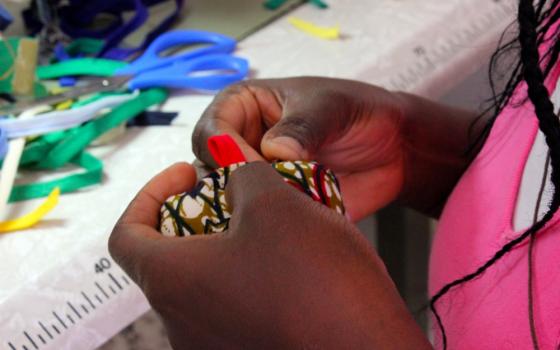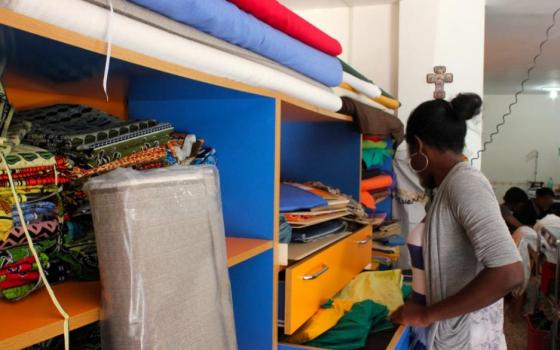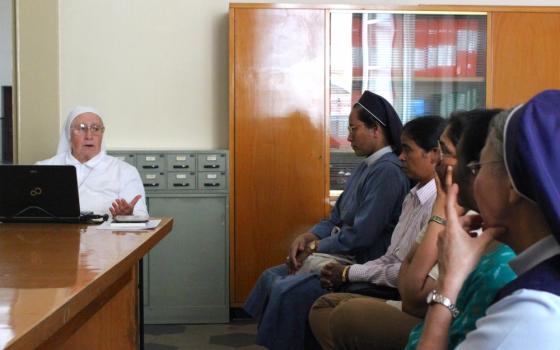The girl was waiting at the sisters’ gate one morning in August.
Before her 18th birthday, Elizabeth had already traveled across the Sahara and the Mediterranean on her way from Nigeria to Europe and spent six months in a brothel in Denmark. She was being prepared to start working on the streets of Italy when she found her way to Casa Rut, a safe house for trafficking victims.
Elizabeth is among the hundreds of thousands of migrants who have taken the perilous journey to Europe in recent years. An estimated 3,343 migrants have lost their lives at sea in the last year, even as Italy rescued 150,000 people through its now defunct Mare Nostrum program.
But when migrants land in Italy, they’re greeted by the realization that it is not a land of opportunity. While European policymakers debate how to respond to the influx of migrants, human traffickers are ready to take advantage of the chaos.
In the decades that women religious have been fighting trafficking in Italy, they have learned that their network must adapt as quickly as the traffickers’ networks. But the heart of their work remains the same: restoring women’s dignity so that they can build a new life.
Prostitution is hardly new. Not far from Casa Rut in Caserta, tourists visit the ancient Roman city of Pompeii, where a favorite attraction is the ancient brothel. Here, the guidebooks will tell you, slaves from around the Roman Empire served local clients and handed their earnings over to their masters.
Millennia later, migration following the fall of the Iron Curtain and war and famine in Africa in the late 1980s generated an increase in sex trafficking. It continues with today’s wave of migrants.
“Even women – young women, children – have become commodities,” Sr. Eugenia Bonetti said. “We speak a lot about ‘globalization,’ but we are revising even the market for human beings.” As the director of the Counter Trafficking Office at Union of Italian Major Superiors (USMI), Bonetti, a Consolata Missionary sister, coordinates the efforts of 250 sisters who work in 100 convent-safe houses across Italy.
Italian groups had contact with nearly 24,000 victims in 2012, according to a study released last fall. Most were women from Nigeria and Romania (but groups fighting prostitution are more common than those fighting labor exploitation). Bonetti, though, estimates that Italy has 70,000 to 80,000 victims at any given time.
Numbers of trafficking victims in Europe pale in comparison to the numbers in the developing world. The International Labour Organization estimates that 20.9 million people are enslaved worldwide, with 22 percent of victims trafficked for sexual exploitation.
But Europe, idealized by migrants from around the world, still has a significant sex trafficking problem. Even as the increasing number of migrants gives rise to more labor exploitation, sexual exploitation accounts for 62 percent of trafficking cases detected in Europe.
Italy, as the most significant transit route into Europe, reflects the trend. Here, as in Germany and the Netherlands, sisters’ ministries with the poor put them in the position to recognize and respond to the problem early on.
Traffickers prey on the poor.
Elizabeth, for instance, grew up in a family with four younger brothers. Her family couldn’t afford to educate her, so when she was 13, her mother gave, or perhaps sold, her to a hairdresser. While working as a servant for the woman, she met a man who said he would help her. He’d pay for her to go to Italy, and she could pay him back when she got there.
In the past, traffickers might have beaten their victims into submission, Bonetti said, but this would force them to run away. Today, they often employ psychological manipulation.
The women are given “contracts,” as if they were legitimate workers, but the terms are extreme. Women typically must pay back 60,000 euros (nearly U.S. $75,000) plus expenses for food, shelter and even their spot on the street. Voodoo rituals sometimes bind Nigerian girls to their traffickers, threatening horrible consequences if they break their contracts.
It was the contract that kept Mary, another Nigerian woman, now 31, on the street. Mary’s story is “the case where somebody sees a problem and tries to take an advantage over a person who is suffering,” as she puts it.
Mary and her siblings were orphaned at a young age and had only each other. She doesn’t remember how she met the woman who trafficked her back in Lagos, Nigeria, but only that “I saw her at first like some kind of angel sent to help,” Mary recalls. “I was offered a better life. You can help your family; you can work and change your circumstance.”
At 25, she boarded a plane to Italy, but, “When I got here it was a different ballgame,” she said. She was told there were no opportunities except for prostitution.
Mary felt she had freedom because her madam stayed in Nigeria, but she still felt bound by the contract. “What was expected of me was, at the end of the day, “Whatever you do, make sure you pay my money,’” she said.
That money went back through an underground system for transfers. Criminal networks involved in trafficking are international.
After eight months on the streets, she tried to run away, but her madam would threaten her siblings, still in Nigeria. “I didn’t change my number so it didn’t look like I disappeared into thin air,” Mary said. “I wanted them to understand that, ‘OK, fine, I know I’m in debt, and I’ll pay you.’”
Two years ago a friend recommended that Mary seek help at Casa Rut in Caserta, a small city near Naples. The sisters, she said, finally convinced her to change her phone number and cooperate with the police. Since then, the threats have stopped – for her and her siblings.
In many African countries, corruption is so bad that the police are not to be trusted. Traffickers also warn their victims against going to police since they are often living in the country illegally.
As migrants flood the port cities of southern Italy, this lack of trust makes protecting them more difficult.
“The bad people are in their country, they’re on the boat with them, and they’re here waiting for them. They are connected,” said Sr. Valeria Gandini, a Comboni Missionary sister who works on trafficking issues in Palermo, Sicily.
A representative from the International Organization for Migration talks with the women when they first arrive, Gandini said. One or two may step forward and report that they’ve been trafficked, but few are willing to ask for help in front of a group that may include their trafficker.
Instead, the women are transferred to refugee camps, where they apply for asylum and await the results. Italy doesn’t restrict their movement, so the migrants often run away from the government-funded but privately run centers.
Although about 40,000 migrants entered Italy through the Mediterranean in the first half of 2014, few more than 20,000 applied for asylum in Italy. An Italian government report found that 3,163 of the 12,164 unaccompanied minors arriving in Italy in 2014 are “unavailable.”
Most migrants leave the reception centers before applying for asylum in Italy to continue their journeys to Northern Europe, but the looseness of the system also opens the door to those who want to exploit migrants.
For this reason, Bonetti is now organizing a group of convents to take in female migrants. They hope to protect them from falling into the hands of traffickers to begin with.
Elizabeth’s story of being trafficked from one of these centers is not likely an isolated case, said Sr. Rita Giaretta, the Ursuline sister who helped start Casa Rut. Lay associates helped put together a report based on Elizabeth’s case, calling on the government to provide better protection for unaccompanied minors.
Though Elizabeth was 17 when she arrived in Italy, she was transferred to an adult refugee camp instead of a secure facility for minors. She only ate and slept there. While she was out, a Nigerian man befriended her, buying her clothes, taking her out to dinner and promising to take care of her.
Trusting her countryman over the Italian authorities, she left with him for a “trip” to Denmark, using false passports. But after a few weeks in Denmark, he told her, “Now you have to work.” At the brothel, she earned 100 euros per service, and he kept all of it.
“There is no control,” Giaretta said. “The traffickers are dancing because it’s a very favorable situation for them.”
Back in Italy after six months, Elizabeth found her moment to escape when her “boyfriend” was in the bathroom at 5 in the morning. She ran to the train station and hopped on the first train, which happened to go through Caserta.
On the train, she asked fellow migrants for help. An Italian overheard her plight and offered to take her to Casa Rut. There, she waited at the gate until the sisters found her at 8 a.m.
“We are not happy that Elizabeth is with us because we would like her to have been protected before,” Giaretta said. “We don’t want to be nurses to heal wounds that could be avoided.”
There are too many who are wounded already. One parish-based ministry meets 25-30 women in a night on a single road on the outskirts of Rome. They bring tea when it’s cold and water when it’s hot. The women will even be there with umbrellas in the rain.
They approach them in “their language, the language of love,” said Sr. Monica Onwunali, a member of the Missionary Sisters of Our Lady of Apostles. In Nigeria, she worked with victims of trafficking who had been returned from Europe, welcoming them home. Seeing them in the street is much more difficult, she said.
The volunteers spend 30 minutes with one or two women, asking how they are, how their family and friends are, and whether they’re getting customers. They’ll connect them with doctors if they need medical attention. “We just want to tell them that somebody cares,” she said.
Even though they’re not there to preach or make them change right away, it’s difficult to see so few willing to leave, Onwunali said. It’s economics, though. “If I have enough money, I can get out,” Onwunali hears. “I just need three or four years more.”
When sisters go out on the road, they see cigarette burns and other signs of abuse. “We use and throw them away,” Gandini said, recalling the murder of two women in Palermo a few years ago. One body was found at the landfill, and the other in a dumpster.
Many women come to Casa Rut from the hospital – injured, sick or pregnant. The sisters go to the hospital outside visitors’ hours so they can talk to the women alone and help them escape. Other trafficked persons reach a breaking point and turn themselves into police, not caring whether they’ll be deported back to their home countries in shame.
Every Saturday Bonetti leads an international team of women religious to visit an “identification and expulsion” center for undocumented migrants. Many of the women they meet are trafficking victims who are unaware of their rights.
In a large part, thanks to the lobbying power of Bonetti, Giaretta, Gandini and other women religious, Italian law recognizes the women as victims instead of criminals.
As a part of the night ministries, volunteers distribute information about a national hotline for victims seeking help. They have the right to stay in Italy as long as they take part in a rehabilitation program. They can, but don’t have to, cooperate with police investigations.
Though Casa Rut started in 1995, Bonetti and her colleagues pushed their fellow sisters to take on this work in a concerted way for the Jubilee year of 2000. They recruited 100 convents to open their doors to victims of trafficking as rehabilitation programs. Bonetti said the sisters have saved 6,000 women from prostitution this way.
But it’s not easy work. Women who’ve been on the streets are full of rage.
“You no longer see yourself as a human being,” Bonetti explains. They have forgotten when to eat and sleep and how to interact with people in a civilized manner.
“They can find a bed; they can find a house, but they have to find inner freedom,” said Giaretta, who has helped more than 350 women escape prostitution through Casa Rut. “You have to accompany them. For each one, the journey is different.”
Casa Rut consists of an apartment where four Ursuline sisters live, plus an attached unit with four rooms for the women and their children. They live, eat and pray together as a family, and they try to keep the number of women small.
Elizabeth arrived at Casa Rut on Aug. 12, days after her 18th birthday, and within a month, the sisters had worked with the Nigerian embassy and Italian government to secure her permit to stay in the country. Soon, she would start language classes and vocational training to prepare her to integrate into Italian society.
Mary, meanwhile, is at the end of her time with Casa Rut. She lives with her two sons and another woman in an apartment owned by the sisters and works at a cooperative started by Casa Rut to provide the women with employment. Trafficking victims need to maintain a program of study or a work contract in order to stay in Italy legally. Soon the sisters will help her find her own place to live.
Mary needed the time to accept the idea of being a mother, Giaretta said. As victims of violence, the women are often unable to convey serenity to their children.
More than 60 children have come through Casa Rut. The women often ask the sisters to assist at the birth, Giaretta said, laughing that they are no longer barren.
The sisters may be like mothers and grandmothers, but they also have to know when to let go and give the woman the space to build a relationship with her child. “We try to support the mother to be the mother,” she said.
While secular NGOs run shelters in Italy as well, Bonetti emphasizes that, for sisters, working with the women is “their life.” They aren’t simply staff who rotate in and out with each shift, but people who come to know the women deeply.
“I’m surrounded by people who love me and who love my children; people who see the best in me – even though I don’t – and try to bring the best out of me,” Mary said.
The women they work with stay in touch for years, calling when they need help. In recent years, the sisters have received more calls from women who have lost their jobs in the economic recession and haven’t been able to maintain their legal status in Italy. This precarious situation can push women back into prostitution.
Always adapting, the sisters developed a pilot program allowing Nigerian trafficking victims to voluntarily return home. About a dozen women and their children have gone back with financial support for housing and a small business, such as a shop or hair salon.
Giaretta hopes to keep the women employed in the first place through New Hope Cooperative. In a small store front in Caserta, Mary spreads fabric with colorful African prints on a large work surface to cut it. Across the room, other women are sewing tags on fabric key chains and stuffing pillows. Members of the coop earn a base salary of 900 euros (about U.S. $1,100) a month, plus additional pay depending on how many children they have.
“I see myself more as someone who’s productive – somehow making the world a better place now,” Mary said. “I feel more needed, in a good sort of way.”
But even Mary would like to return to Nigeria someday. Her dream is to open an orphanage so that other vulnerable people won’t be taken advantage of. “What I hope for is being able to somehow pay back for what I’ve been given,” she said.
Reporting for this article was supported by a grant from the International Reporting Project (IRP). Names of the trafficking victims have been changed to protect their identity.
[Megan Sweas is a freelance journalist based in Los Angeles who writes about social and economic justice issues and world religions.]





